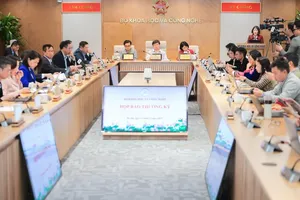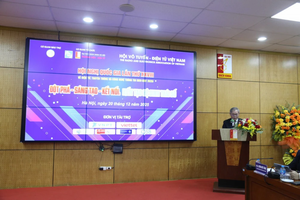
This was heard at today’s conference to announce the Information and Communications Infrastructure Planning for the period 2021-2030, with a vision to 2050 organized by the Ministry of Information and Communications in Hanoi.
Accordingly, by 2030, all users will be able to access speeds of over 1Gb/s and 5G mobile broadband network will cover 99 percent of the country’s population, aiming to develop the next generation of advanced mobile networks. Moreover, the country will have additional 4-6 international undersea fiber optic cable lines.
According to the Prime Minister’s Decision No. 36/QD-TTg on information and communications infrastructure planning for the period 2021-2030, vision to 2050, the information infrastructure and communications is a unified whole based on the connection between the postal network, digital infrastructure, information technology industrial infrastructure, national digital transformation platforms and network security.
Additionally, the Southeast Asian country will develop information and communications infrastructure for national digital transformation, opening up new development space for the economy and society; therefore, it will create a favorable environment for innovation to improve national competitiveness. With this plan, Vietnam sets high goals in developing information and communication infrastructure, creating infrastructure for the development of digital government, digital economy, and digital society.
Regarding postal services, the country aims for the total service exploitation capacity of the postal network of over 93,000 tons of postal items a day by 2025; plus, the maximum time for inter-provincial and international delivery is 5 days while the maximum time for local delivery is 2 days.
Moreover, the country will form three regional postal centers across the country to ensure an average exploitation capacity of over 11,000 tons of postal items a day, an average service range of 350 km while forming 14 regional postal centers across the country to ensure an average exploitation capacity of over 4,500 tons of postal items a day, with an average service range of 115 km.
What’s else? By 2030, 3-5 regional postal centers will be built across the country with the average exploitation capacity of postal centers reaching over 15,750 tons of postal items a day and regional postal centers have an average capacity of over 5,000 tons of postal items per day.
Regarding digital infrastructure, the plan aims for all households will have access to fiber optic cable based on a fixed broadband network; thus, 90 percent of users will be able to access fixed, medium-speed Internet with an average 200 Mb/s by 2025. Along with that, 90 percent of socio-economic organizations such as enterprises, production and business establishments, schools, hospitals, and offices in urban areas can access the Internet with an average speed of 1 Gb/s. All Vietnamese adults can afford a smartphone as well.
Besides, all high-tech parks, large information technology parks, research, development and innovation centers can access the Internet with a minimum speed of 1Gb/s. Most Party and State agencies from central to commune level will be connected to the specialized data transmission network and essential infrastructure such as transportation, energy, electricity, water. Urban areas are capable of integrating sensors and IoT applications. Furthermore, all Government agencies use the cloud computing ecosystem to serve the Digital Government.
Last but not least, 70 percent of Vietnamese businesses use cloud computing services provided by domestic businesses while the government will invest in 2-4 additional international telecommunications cable lines. National data centers, at least 3 national multi-purpose data center clusters, regional multi-purpose data center clusters and 1-2 regional data centers will be formed for the needs of financial centers in Vietnam, the region and the world.
By 2030, national-scale digital platforms will be completed and operate smoothly to meet the requirements of digital government, digital economy, and digital society; hence, all people can access and use advanced digital services with high quality and reasonable prices.
Regarding network information security, network security for digital government, digital economy and digital society, all ministries, ministerial-level agencies, and people's committees of provinces and centrally-run cities ensure network information security according to the 4-layer model by 2025.
In addition, internet users have access to information, awareness-raising materials, skills and tools, and basic network information security services. Vietnam's cyber information security product ecosystem has various types with the development of 3 - 5 key information security products and services dominating the domestic market and competing with other countries.
By 2030, Vietnam will become one of Asia's leading centers for ensuring network information security and network security. A market will be set up to ensure network information security and network security.
What’s more? The country will implement schemes and projects of 12-14 large information technology parks and other facility members of the software park chain and 16-20 big information technology parks and other facility members by 2025 and 2030 respectively.
Speaking at the conference, Deputy Minister of Information and Communications Phan Tam said that information and communication infrastructure is placed in connection and synchronization within and between sectors so that it can become the infrastructure of infrastructure and the foundation for the development of industries and fields. The plan is oriented to resolve issues related to intra-sectoral and inter-sectoral alignment and synchronization and promote the development of difficult areas and promote regional advantages across the country.
Deputy Minister Phan Tam affirmed that information and communications infrastructure is the infrastructure for national digital transformation, opening up new development space for the economy and society. Information and communications infrastructure is identified as one of three strategic breakthroughs, so it is necessary to prioritize investment to ensure harmony between economic development and social security. Successful implementation of the plan will create motivation and development space for the information and communications sector to maximize the potential and advantages of the industry and the country’s rapid and sustainable socio-economic development.
























